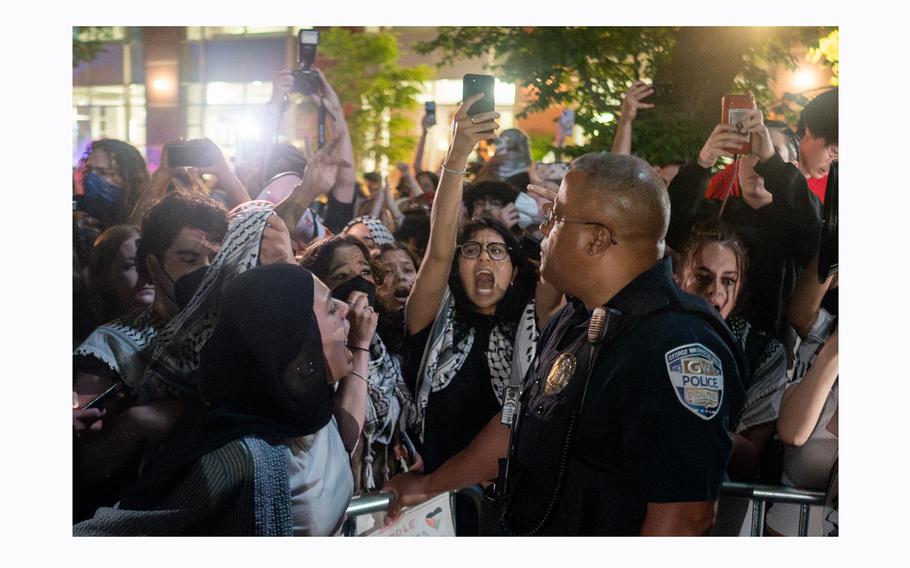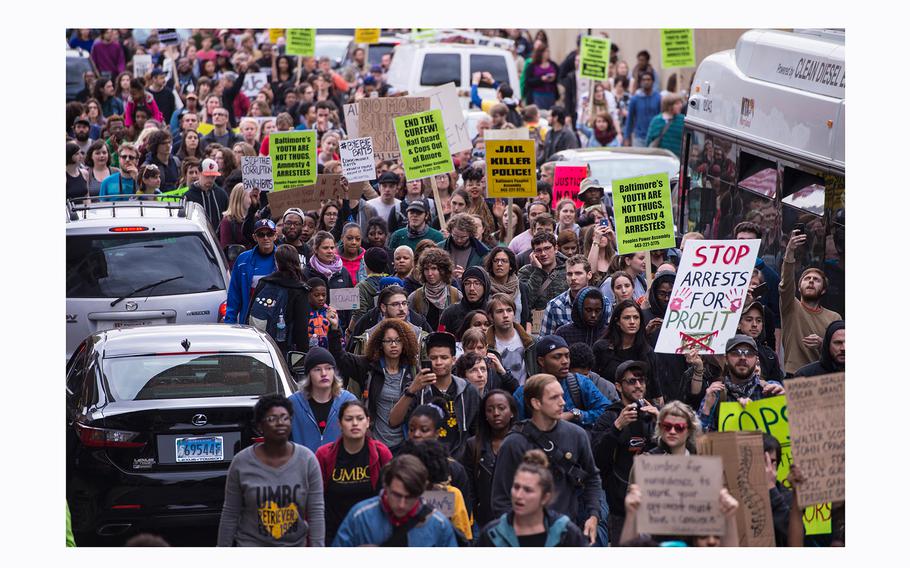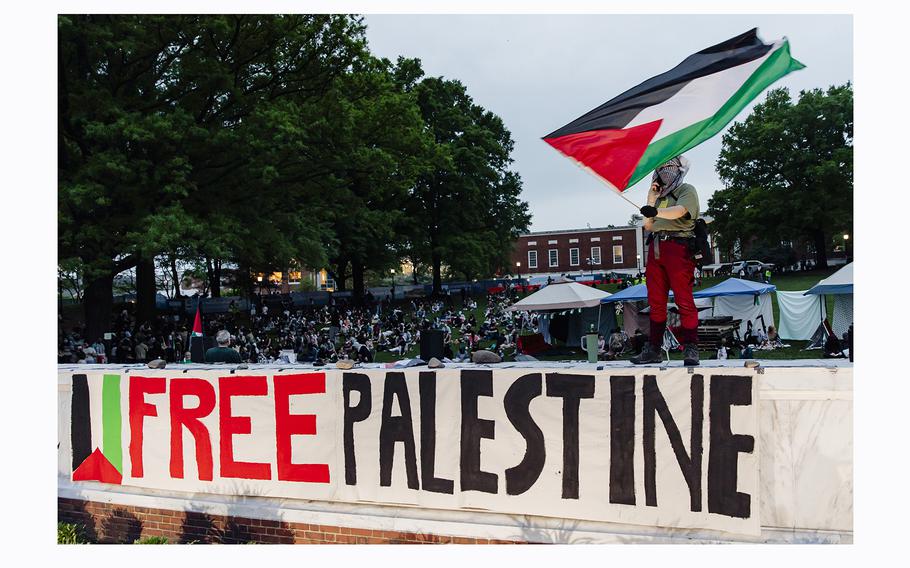
A police officer looks on as protesters shout after breaking through barricades to enter the University Yard encampment at George Washington University in Washington on Sunday, April 28, 2024. (Jordan Tovin for The Washington Post)
New York police had just poured into Columbia University, clearing protesters out of an occupied campus building and arresting more than 100 people in a far-reaching crackdown at the epicenter of the nation’s uprisings over the war in Gaza.
But within hours of the police moves Tuesday night, Mahmoud Khalil, a pro-Palestinian student leader, said he and others were already planning their next action.
“Or actions,” said Khalil, foreshadowing the continued resolve of the movement. “Until we finish this semester and come back next semester.”
Khalil’s determination to press the movement forward, repeated by countless students at universities across the country this week, showcases how protesters are determined that their calls for the end of the war and university disinvestments from Israeli companies won’t slow down much over the summer.
“No one plans on leaving this summer,” Selina Al-Shihabi, a Georgetown University student who is part of the still-growing encampment at George Washington University in Washington, said Wednesday. “That is very clear among the people with us today, and it’s something we meet about, something we chant in our slogans.”
The stakes over what this summer may hold has far-reaching consequences for students, college administrators, big-city mayors, police agencies and President Biden. Some Democrats worry that scenes of upheaval this summer, especially at the party’s August convention in Chicago, could damage Biden’s reelection campaign.
Speaking at the White House on Thursday, Biden appeared to recognize that there would be no quick end to the demonstrations, even as he sought to carve out a middle ground.
“Dissent is essential to democracy,” Biden said. “But dissent must never lead to disorder or to denying the rights of others so students can finish the semester and their college education.”
Yet at least for college administrators, many of whom have asked for police to break up their schools’ encampments, the end of spring classes leaves some room for optimism that their campuses will see a bit of break in the action over the summer. Just how much, however, is rooted in a more fundamental debate over whether the protests that rocked colleges this spring represent a sustained generational movement or a short-term political fad.
Answering that question is complicated because experts are divided over whether the student-led movement is really just getting started or destined to fail when most students scatter for the summer. Some experts point to the struggles other social movements, including the 2011 Occupy Wall Street protests against corporate greed, faced once they no longer had an anchor or highly concentrated encampments and command centers from which to carry out their movement.
“Many of those students, except for the most die-hard activists, are going to go home - and that’s going to de-escalate and demobilize it,” said Dana R. Fisher, a professor at American University and author of a book about activism. “Any campuses where you have most of the student body in student housing … in the summer, you’re going to really lose people.”
The trajectory of a social justice movement has vexed historians and political leaders in the past. The most successful movements stay relevant by crowding out other news while melding into history books by continually challenging and surprising authorities, they said.
During the civil rights protests, young people found ways to step up their activism over the summer by congregating in specific communities to press their demands, such as the “Freedom Summer” voter registration drives in the South in 1964.
During the Vietnam War, student protesters congregated at music festivals and high-profile political events - including the 1968 Democratic convention in Chicago - to continue pressing their demands. And fours year ago, when the nation was largely shut down due to the pandemic, the summer season did little to prevent students from mobilizing in their individual cities to condemn the murder of George Floyd by Minneapolis police.

Protesters march by the Baltimore Central Booking and Intake Center on May 1, 2015, after it was announced that criminal charges would be brought against all 6 officers involved in the Freddie Gray case (Jabin Botsford/The Washington Post)
But all those movements were far larger than the pro-Palestinian student movement remains today. At many colleges, a relatively small number of students are leading the calls for a cease-fire or changes to university investment policies.
To sustain and grow their movement, experts say, these students will have to find ways to align and coordinate with other left-wing interest groups and potentially shift their tactics farther away from campuses.
The failure to do that effectively was one of the downfalls of the Occupy Wall Street movement, said the Rev. Michael Ellick, a pastor who led the “occupy faith” component of the movement that took over New York’s Zuccotti Park until a series of police raids on the encampment in the fall of 2011. Even those camps that police allowed to remain operating for longer periods of time, such as the one on National Park Service land in Washington, eventually fell victim to internal divisions, filth, drug abuse and rats.
“The key to sustaining the movement was everyone being there in person and having a culture develop,” Ellick said. “As soon as those camps got wiped away, that movement was basically hard to keep going in the same way.”
“Then it depended on old-fashioned organizing,” Ellick added. “Like relying on community relationships, and building solidarity with different networks, which some aspects were really good at, but some were not at all so of course it faded away.”
Lisa Fithian, a veteran liberal activist who has been demonstrating since the 1980s and now teaches guerrilla tactics to younger activists, said she is fully confident in the pro-Palestinian demonstrators’ ability to press - and intensify - their movement over the summer.
Earlier this week, Fithian was at City University of New York (CUNY) and Columbia holding impromptu trainings about how protesters can place their bodies on the line to affect social change.
Fithian, a veteran of protests over both Iraq wars and the Standing Rock demonstrations over the Dakota Access pipeline, said the students have already built the network of support needed to sustain the movement.
Fithian also said the police crackdown on the protesters offers to promote synergy between their demands and those of the broader racial justice anti-police-brutality groups, which she expects will continue to energize the protests.
“You have a generation that is both very upset, very disturbed, and very angry over now being met with a state response that is completely disproportionate,” Fithian, 63, said.
Eva Borgwardt, national spokesperson for IfNotNow, a Jewish-led pro-Palestinian group, noted the students are already part of a coalition of protesters who have been working for years to bring more attention to the plight of Palestinians. That movement, Borgwardt noted, has far more outlets to vent their frustration than just college campuses.
“This moment is the result of decades of organizing and movement building,” Borgwardt said. “And we are watching today’s organizers learn from prior movements, and apply those lessons in real time in the street.”
At a protest encampment at Johns Hopkins University in Baltimore, students were handing out papers that detail their demands, instruct participants how to act and whom they should not talk to, and how to treat ailments such as “handcuff injuries.”
The students, none of whom would agree to be identified by their full names, vowed their movement is just getting started and will persist all summer.
But Benjamin Jancewicz, a photographer who has been documenting the Baltimore protest movement since the uprising over the 2015 death of Freddie Gray in police custody, cautions that being “well organized” may not be enough unless the demonstrators form alliances with other Baltimore-based social justice groups.

A demonstrator waves a Palestinian flag in front of a few hundred students protesting the Israel-Gaza war Tuesday, at Johns Hopkins University’s Homewood Campus in Baltimore. (Wesley Lapointe/The Washington Post)
He noted Baltimore has a “history of activism that stretches back to the Black Panthers” but it’s relatively rare for demonstrations to grow large enough to elicit broad public attention.
“All of those groups have different things that they are fighting for. All of them have different things they believe in,” Jancewicz said. “But occasionally something like this will happen, and people will be like, ‘okay, we are going to put our stuff at the side for the moment and march with you guys.’ So we will see if that happens.”
In Louisville, a city consumed by protests in 2022, veteran Black Lives Matter activist Chanelle Helm believes the pro-Palestinian activists have already formed a tight alliance with racial justice demonstrators. Helm, who is Black, believes many racial minorities already feel sympathy toward the Palestinians, and the police tactics being used against pro-Palestinian demonstrators only strengthen that bond.
“I don’t see these as cross movements, as we would look like at environmentalism or technology movements,” said Helm, who was at the forefront of the demonstrations over the death Breonna Taylor in Louisville in 2020. “The lines have already been meshed. The Middle East is full of Black people.”
With fewer students on campus this summer, Helm said the demonstrators may briefly shift to new venues. And even if protests briefly die down, Helm said, it would be a mistake to assume that the movement had petered out.
“The most important thing that people have to understand about protests is that the actual protest is only like 5 percent of the work,” said Helm, adding the vast majority of time is spent on “creating narratives,” reading up on history, building resources and allies, and training demonstrators.
At the George Washington University encampment, Al-Shihabi said that is precisely how the students plan to spend their summer.
Al-Shihabi said student leaders are already forgoing summer jobs and internship plans to continue their activism.
“Every single student here obviously needs money,” she said, while standing in an encampment that now includes a shower and portable toilets, as well as at least one large rat that felt safe enough to scurry past in the middle of the day. “Everyone needs to have future careers. … But they are putting all of that at bay because they care about the greater good of humanity.”
Kaden Ouimet, an American University student government leader who has been protesting at the George Washington University encampment, also plans to stay in Washington this summer instead of returning to his hometown in Arizona. He plans to help craft a detailed plan for university divestment, conduct research, and strategize over how to woo incoming freshman to the pro-Palestinian cause this fall.
“We hope we can come back from summer stronger in our convictions than ever,” Ouimet said.
At many schools, the fall courses will restart in mid-August, around the time of the Democratic National Convention from Aug. 19 through Aug. Aug 22.
Justin Hansford, executive director of the Thurgood Marshall Civil Rights Center at Howard University, said he believes this summer has the potential to “be the culmination of protest politics” because the students protesting today started taking lessons when they were in high school during the 2020 Black Lives Matter demonstrations.
“I think what could happen this summer could be even bigger than the George Floyd one,” said Hansford, who was a Black Lives Matter protester before he became a law professor. “There are a number of people being brought into the [movement] not just from a racial perspective, but also religious tolerance and antiwar politics … so there is not a lot to make me think this is just going to let up.”